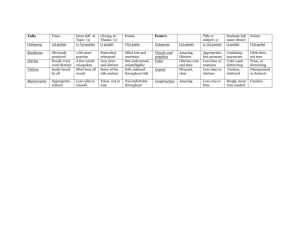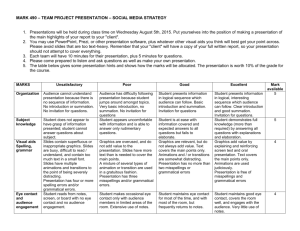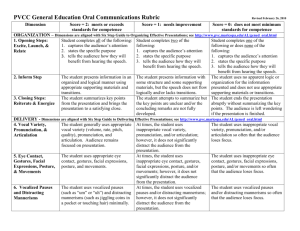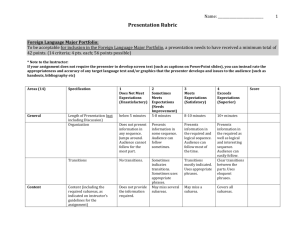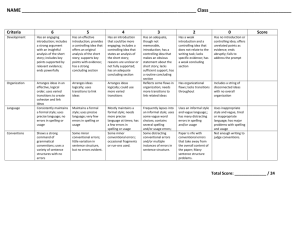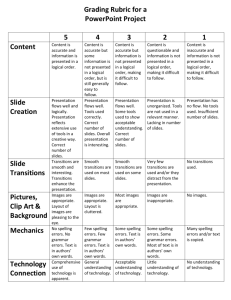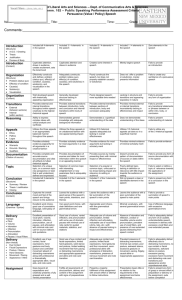Individual Presentation Rubric
advertisement
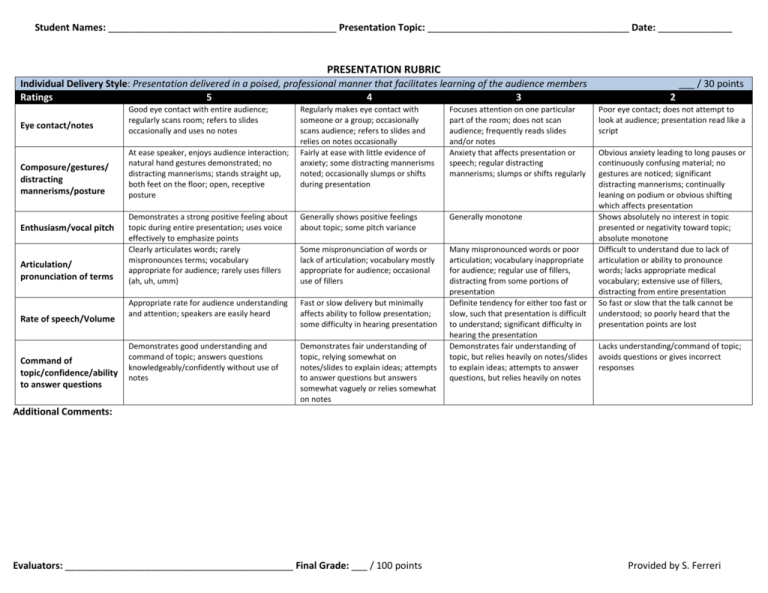
Student Names: ___________________________________________ Presentation Topic: ______________________________________ Date: ______________ PRESENTATION RUBRIC Individual Delivery Style: Presentation delivered in a poised, professional manner that facilitates learning of the audience members Ratings 5 4 3 Eye contact/notes Composure/gestures/ distracting mannerisms/posture Enthusiasm/vocal pitch Articulation/ pronunciation of terms Rate of speech/Volume Command of topic/confidence/ability to answer questions Good eye contact with entire audience; regularly scans room; refers to slides occasionally and uses no notes Regularly makes eye contact with someone or a group; occasionally scans audience; refers to slides and relies on notes occasionally Fairly at ease with little evidence of anxiety; some distracting mannerisms noted; occasionally slumps or shifts during presentation Focuses attention on one particular part of the room; does not scan audience; frequently reads slides and/or notes Anxiety that affects presentation or speech; regular distracting mannerisms; slumps or shifts regularly Demonstrates a strong positive feeling about topic during entire presentation; uses voice effectively to emphasize points Clearly articulates words; rarely mispronounces terms; vocabulary appropriate for audience; rarely uses fillers (ah, uh, umm) Generally shows positive feelings about topic; some pitch variance Generally monotone Some mispronunciation of words or lack of articulation; vocabulary mostly appropriate for audience; occasional use of fillers Appropriate rate for audience understanding and attention; speakers are easily heard Fast or slow delivery but minimally affects ability to follow presentation; some difficulty in hearing presentation Demonstrates good understanding and command of topic; answers questions knowledgeably/confidently without use of notes Demonstrates fair understanding of topic, relying somewhat on notes/slides to explain ideas; attempts to answer questions but answers somewhat vaguely or relies somewhat on notes Many mispronounced words or poor articulation; vocabulary inappropriate for audience; regular use of fillers, distracting from some portions of presentation Definite tendency for either too fast or slow, such that presentation is difficult to understand; significant difficulty in hearing the presentation Demonstrates fair understanding of topic, but relies heavily on notes/slides to explain ideas; attempts to answer questions, but relies heavily on notes At ease speaker, enjoys audience interaction; natural hand gestures demonstrated; no distracting mannerisms; stands straight up, both feet on the floor; open, receptive posture ___ / 30 points 2 Poor eye contact; does not attempt to look at audience; presentation read like a script Obvious anxiety leading to long pauses or continuously confusing material; no gestures are noticed; significant distracting mannerisms; continually leaning on podium or obvious shifting which affects presentation Shows absolutely no interest in topic presented or negativity toward topic; absolute monotone Difficult to understand due to lack of articulation or ability to pronounce words; lacks appropriate medical vocabulary; extensive use of fillers, distracting from entire presentation So fast or slow that the talk cannot be understood; so poorly heard that the presentation points are lost Lacks understanding/command of topic; avoids questions or gives incorrect responses Additional Comments: Evaluators: ___________________________________________ Final Grade: ___ / 100 points Provided by S. Ferreri Content (group): Clear, credible, and well-organized with attention focused on key concepts and interesting data Ratings 5 4 ___ / 50 points 3 2 Presentation matches objectives Presentation matched announced purpose and met all objectives Most objectives addressed Some objectives addressed Presentation was not related to announced purpose Opening statement/ relevance to audience Introduction present, may state how topic impacts audience Balanced representation of material Effective opening which states what the presentation will be covering and/or how topic impacts presenter and audience Balanced presentation of introduction, background, presentation of literature, and application/conclusion Minimal opening statement with little mention of relevance of topic to audience Presentation of material is one-sided or biased; too much emphasis on > 1 section No useful introduction to presentation, audience has no idea what presentation is on Presentation heavy on introduction; background material with little emphasis on studies and application Appropriateness of selected literature in scope of presentation Variety of resources used (primary, secondary, tertiary); minimum 1-2 relevant clinical trials or case reports; reputable sources Variety of resources; clinical trials or case reports presented are not wellmatched to presentation; reputable sources Minimal variety of resources used; some resources not reputable No variety of resources; no clinical trials or case reports; no reputable resources used Studies outlined succinctly and thoroughly; pertinent data and endpoints emphasized Outline of study methods/results appropriate; most relevant data and endpoints described Study outline too comprehensive/superficial; relevant info hard to discern Studies poorly outlined leading to confusion and/or inappropriate endpoints/outcomes presented Conclusions thorough and appropriate for studies and placed into context with similar literature; thoughtful critique/limitations provided Study conclusions could be more thorough; attempted to provide critique with limitations and explanation Superficial conclusions/critique regarding study limitations provided (ie, too much/little data provided) or not emphasized Inappropriate conclusions from presented data and/or no critiques or limitations included Excellent transitions throughout; seamless Good transitions exist but are not seamless Transitions exist and are obvious and not creative No transitions Thoroughly explains all points; makes essential points obvious; talk was organized Majority of points covered in depth; some important points unclear; some organization issues Majority of points glossed over; insufficient depth; difficult to follow talk due to disorganization Many points left out; talk was completely disorganized Valid conclusions/recommendations presented which are supported by factual data; recommendations are specific, practical, and applicable to pharmacy practice Multiple creative instances of active learning; audience very engaged Superficial conclusions/recommendations presented with limited support from data; mostly specific, practical and applicable to pharmacy practice 1-2 creative instances of active learning; audience mostly engaged Conclusions/recommendations presented but they are not supported by data; lack specificity, practicality, or applicability to pharmacy practice No application to practice or conclusions/recommendations not presented 1-2 instances of active learning; minimal creativity and lack of audience engagement No inclusion of active learning or attempts to engage audience Presentation of study (methodology/ endpoints) Critique of study (conclusions and limitations) Transitions Organization/coherence Application/conclusion of presentation Audience interaction/engagement Mostly balanced presentation; too much emphasis on one section Media/Formulary (group): Clear, well-organized, readable, visually appealing, and used effectively to direct audience attention Ratings 5 4 3 Effectiveness of slides Completion of herbal formulary Slide spelling / grammar References on slides ___ / 20 points 2 Effective slides which enrich the presentation and are easily read Too many or too little slides; poor color or font selection Many slides ineffective—too wordy, lack of variety, etc. Slides so poorly constructed that they detract from presentation Formulary completed in entirety; wellsupported justification of use; good future reference value No spelling/grammatical errors Formulary incomplete; weak justification of use Formulary contains inaccurate information Formulary information not submitted 1-5 spelling/grammatical errors 6-10 spelling/grammatical errors >10 spelling/grammatical errors References formatted appropriately throughout (AMA style); at least 5 references listed Occasional reference missing/inappropriate format; 4 references listed References listed inappropriately (ex. references used as slide titles); 1-3 references listed No references listed on slides or in handout
